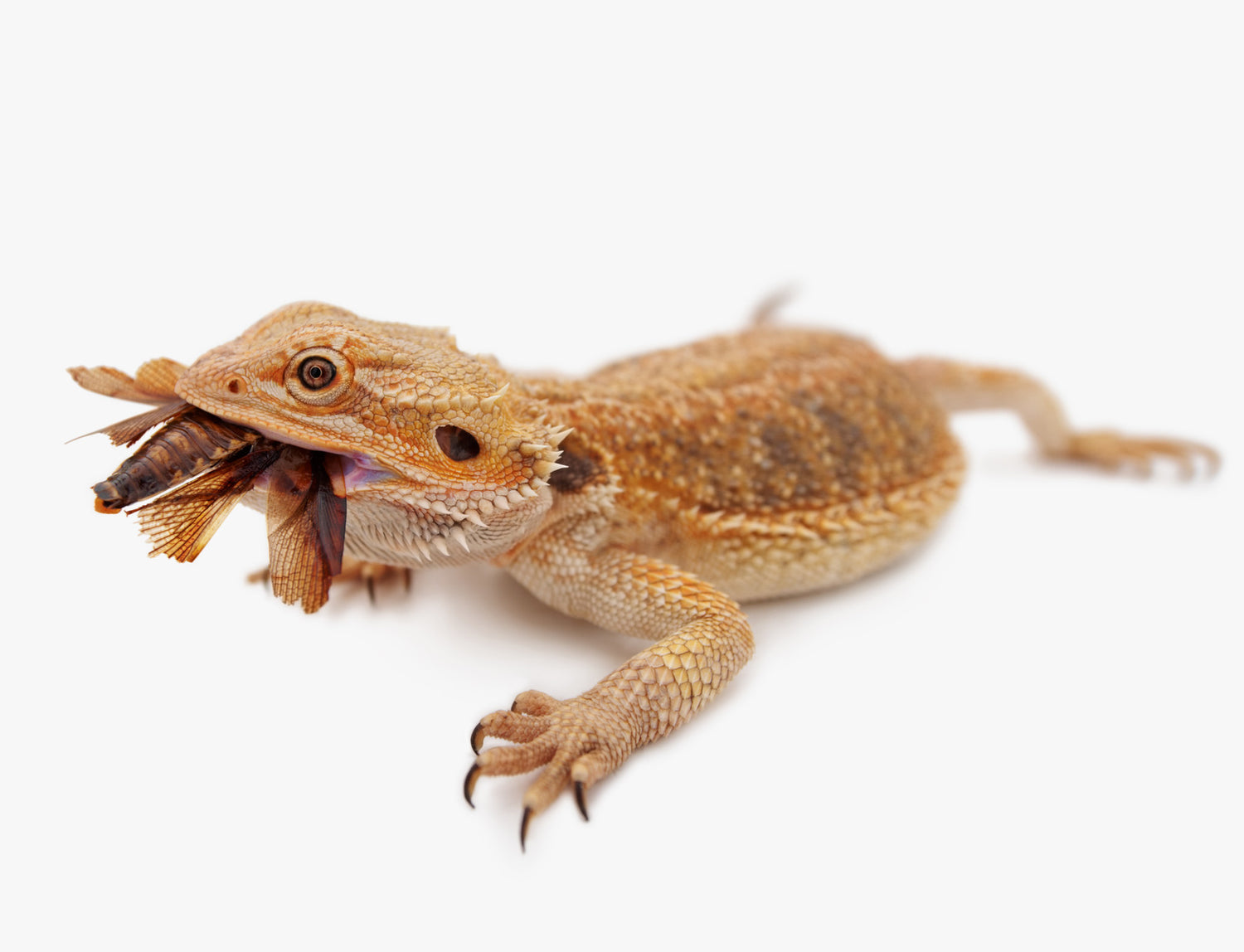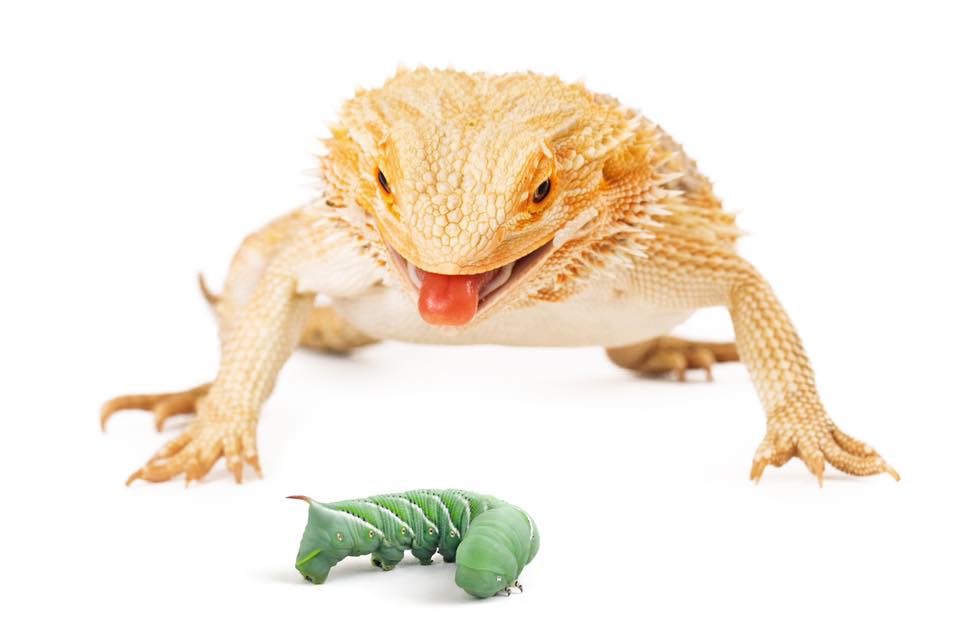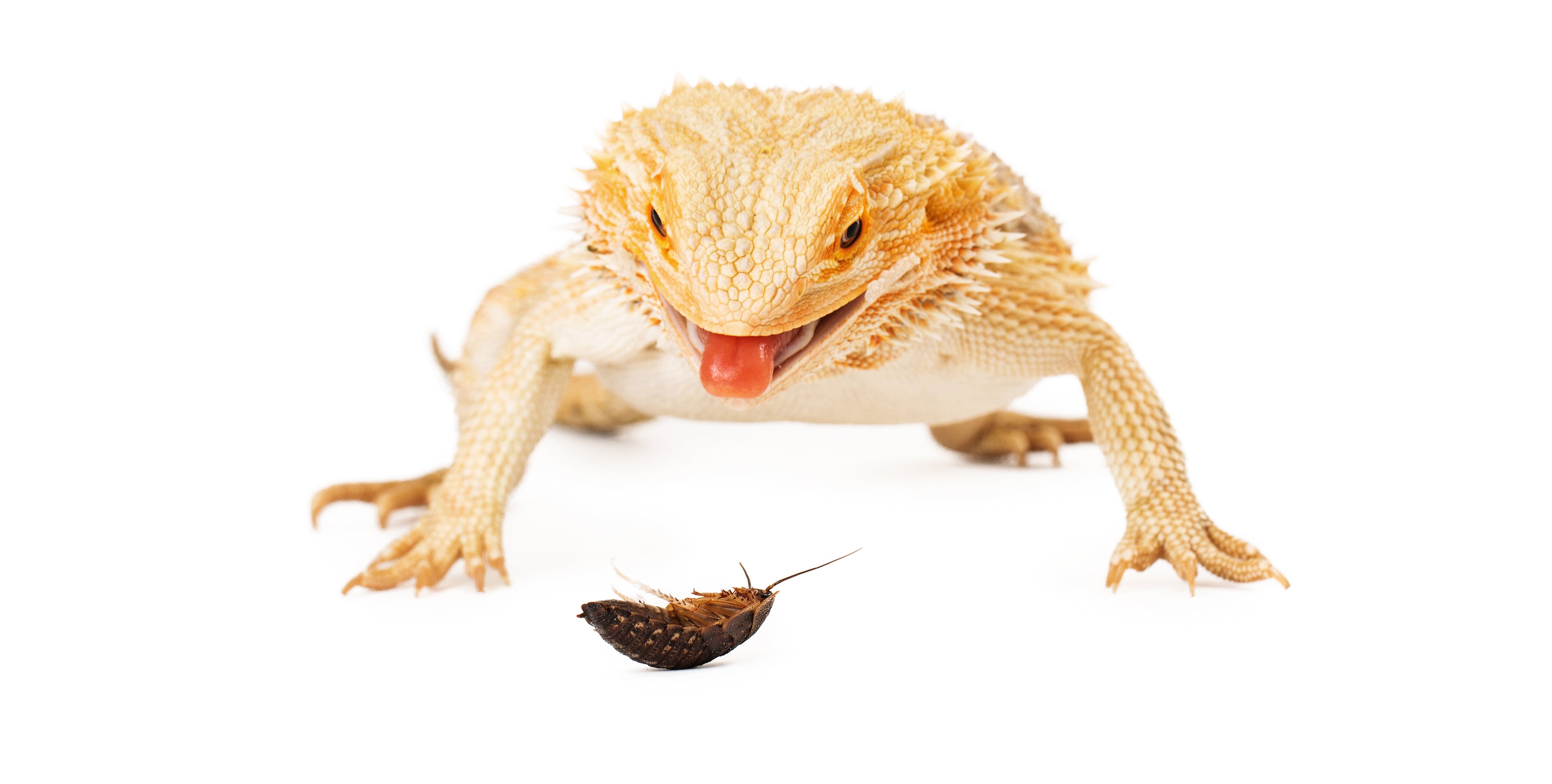Bearded dragons have become highly popular in recent years as an exotic pet to keep, compared to other exotic animals they have relatively easy care needs. Together along with their calm attitude toward humans, it's easy to see how they have become so popular.
Bearded dragons do have particular dietary needs, as do the majority of exotic animals. So what does a bearded dragon need to eat? The following is an in-depth guide to what the bearded dragon's diet is all about.
Bearded Dragon Diet
Bearded dragons are omnivorous, meaning that they need to consume both animals and plant matter to survive. It depends how old the bearded dragon is as to the ratio of animal to plant matter that they need to eat, compared to how much protein. The plant matter they need is in the form of vegetables, fruits, and leafy greens, while the protein takes the form of insects, the vast majority of the time. Baby dragons (0-5 months) need roughly 80% of their diet to be insect protein and 20% of their food to be plant protein, the same can also be said for juveniles (5-18 months) this is because as babies/juveniles the dragon is still growing and needs to absorb protein to fuel its growth. When it comes to young dragons, despite needing mainly veggies they won't always just accept this in their diet, but they still at least need to be offered their salad, gut-loading is a great way to get them to ingest some of their salad through their bugs if you have a fussy dragon.
As your dragon grows into adulthood (5-18 months), they will require the opposite ratio of 80% vegetables to 20% protein. They no longer require so much protein as their body has stopped growing, so the focus changes to needing more vitamins and minerals to maintain their health as they grow older. Again, the dragon may not be accepting of the new ratio of mostly salad as they do love their live bugs! You will need to offer them the correct ratio of more salad and less live insects so that they at get used to having fewer bugs; you will have to be stubborn even if your beardie sulks about having fewer bugs.
What Insects Should A Bearded Dragon Be Eating
Live bugs always tempt dragons because they love anything that wriggles, crawls by, or scuttles around, the movements catch their eye, and they have an instinct to snap them up. This means that they will be tempted to eat anything in their path that behaves this way, so it's up to you to ensure they are only presented with safe insects that meet their nutritional needs. Below is a list of safe feeder insects for your bearded dragon::
- Dubia Roaches (Staple)
- Hornworms (Staple)
- Waxworms (Treat, high fat)
- Black Soldier Fly Larvae (Nutrigrubs) (Staple)
- Butterworms (Treat, high in fat)
- Crickets (Staple)
- Superworms (Staple)
- Mealworms (Staple)
- Other Roaches (Discoid, Turkestan, orange head) (Staple)
- Earthworms (Treat, high in fat)
- King worms (Staple)
- Silkworms (Staple)
NEVER feed your bearded dragon any wild-caught bugs as they could have been exposed to pesticides or parasites that can be passed on to your dragon and make them very sick. "Wild-caught" includes bugs you have found inside your house.
Toxic Insects - IMPORTANT
Your dragon should NEVER ingest these insects, so every attempt should be made to prevent them from eating these. If your dragon does happen to ingest any of the insects below, you can administer a charcoal suspension to your dragon to try and neutralize the poison. At the same time, veterinary attention should be sought if your dragon begins to act lethargic, black beards, and seems out of it.
- Firefly
- Asian Ladybug
- Fire Ant
- Centipede
- Lygaeid Insects
- Ticks and Spiders
- Wasps
Should I Buy Dubia Roaches Or Crickets
Dubia roaches and crickets are two of the most common feeder insects for bearded dragons. Per insect dubia offer more nutrition, but crickets still offer a decent amount, there are a few pros and cons to view when making your choice between each feeder. See below for a list of pros and cons to help you make your choice:
Dubia Pro's
- Are very quiet
- Cannot jump
- Cannot climb smooth surfaces
- Rarely escape
- Have little to no smell
- Have a very long lifespan
- Very clean so don't carry parasites (when purchased from a reputable vendor)
- Breed like rabbits
- Very resilient and hard to kill
- Easy to keep and care for
- Have double the protein and nutrients per insect
Cricket Pro's
- They aren't called roaches (people can get creeped out by the word roach)
- Easy to keep
Dubia Con's
- They stand still (you may have to nudge them to get them to move so a dragon will spot them)
- They are called roaches (people get creeped out by this, but they do not resemble the household roach, so it is easy to get used to)
Cricket Con's
- They are very noisy!
- They jump around when trying to feed your dragon making them hard to catch for your dragon
- They jump out when you open the lid to their container
- They smell bad
- Difficult to breed
- Die easily
- Are dirty and known to carry parasites
- Have half as much protein and nutrition per insect
Dubias Or Crickets
Crickets and Dubia can both provide your bearded dragon with the nutrition that they need. However, there are more cons when it comes to using crickets overusing dubia as your main staple. Dubia have more nutrients per insect, so you don't need to feed as many. Crickets generally have a higher risk of carrying parasites, which can be passed onto your dragon. Overall, dubia are more highly recommended for your dragon than crickets.
Bearded dragons always have their favorites, and you may find that your dragon prefers one over the other. It is recommended to have a variety of feeders in your dragons diet so you can switch it up. One of the main things to consider if you are using crickets is to watch your dragon for signs of parasites and get regular fecal exams.
What Vegetables Should Bearded Dragons Eat
Bearded dragons need insects in their diet, but their vegetables and fruits are just as important when it comes to their health. There are so many options available to choose from, so it can get confusing. Certain vegetables they shouldn't eat, but the following is a list of vegetables that are safe for your dragon:
What Fruits Should A Bearded Dragon Eat
As well as insects and veggies, they can also eat fruit. The sweet smells and bright colors can be tempting and useful as a way to get them to eat their salad in general, the fruit is generally high in moisture and sugar so should only make up about a fifth of their daily salad. The rest should be staple greens and veggies. Below is a list of safe fruit for your bearded dragon:
Certain fruits are missed out on the list for various reasons. Dragons should not have citrus fruits like oranges, lemons, grapefruit, etc. as these are very acidic and can hurt their stomach. This list does not include every single fruit that your dragon can have if you are considering feeding your dragon something that you can't find on the list, then always do thorough research to ensure that it is safe for your dragon to eat BEFORE they eat it.




Leave a comment
All comments are moderated before being published.
This site is protected by hCaptcha and the hCaptcha Privacy Policy and Terms of Service apply.